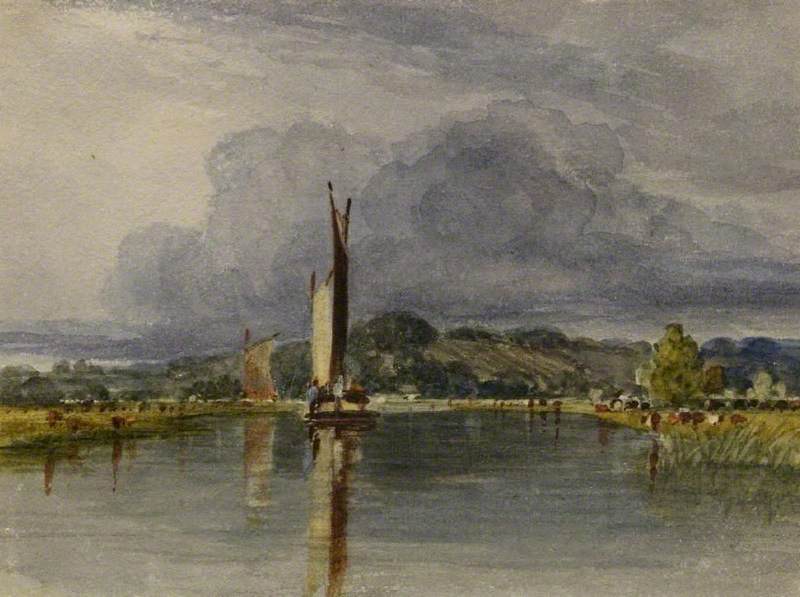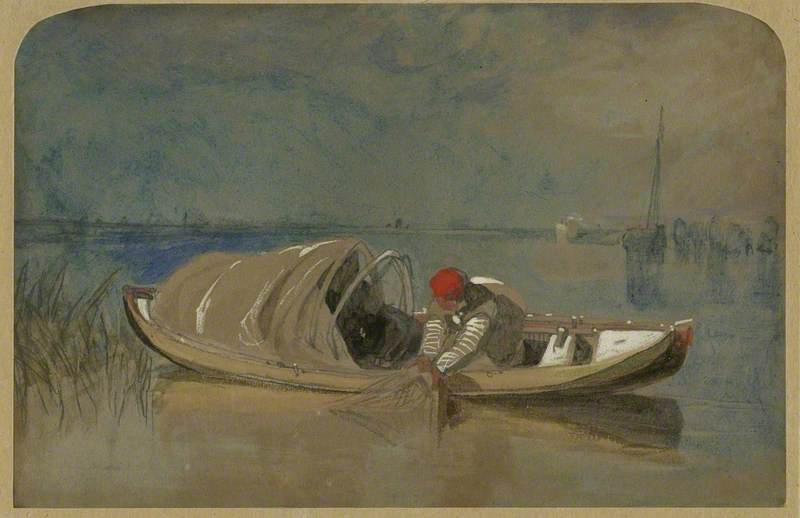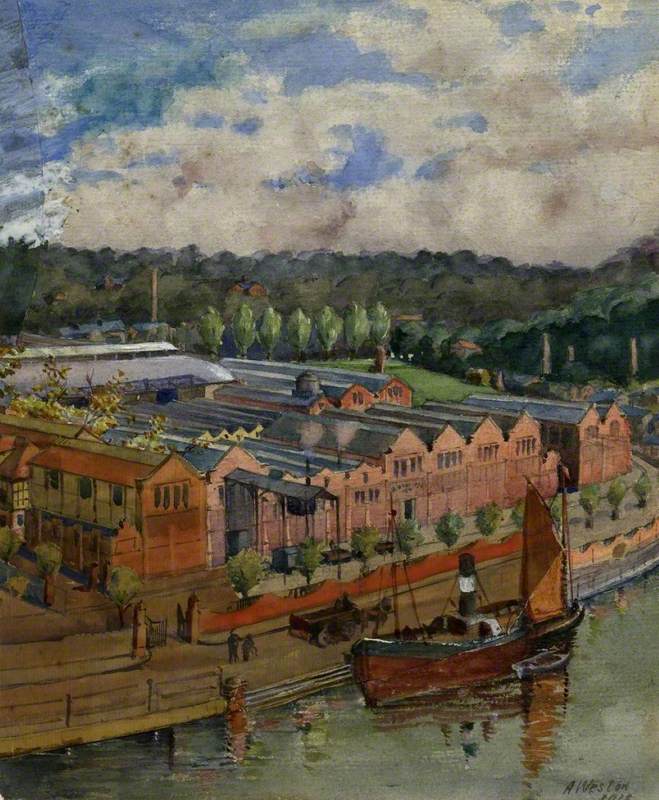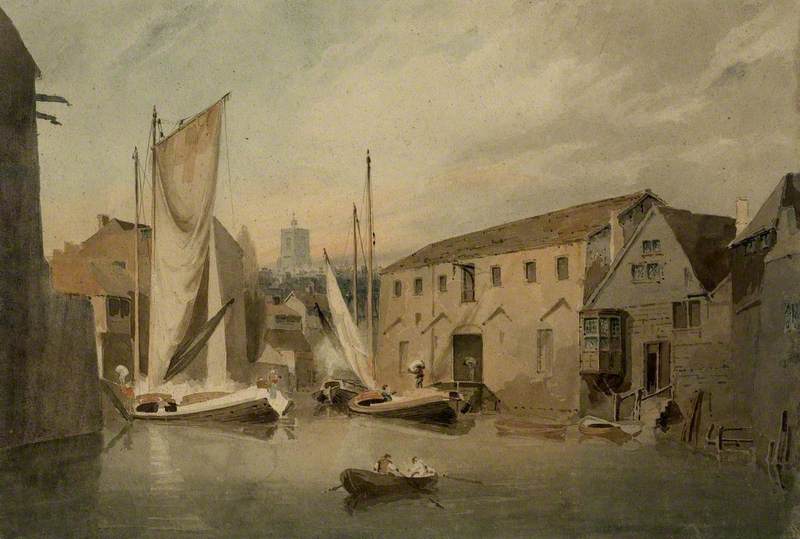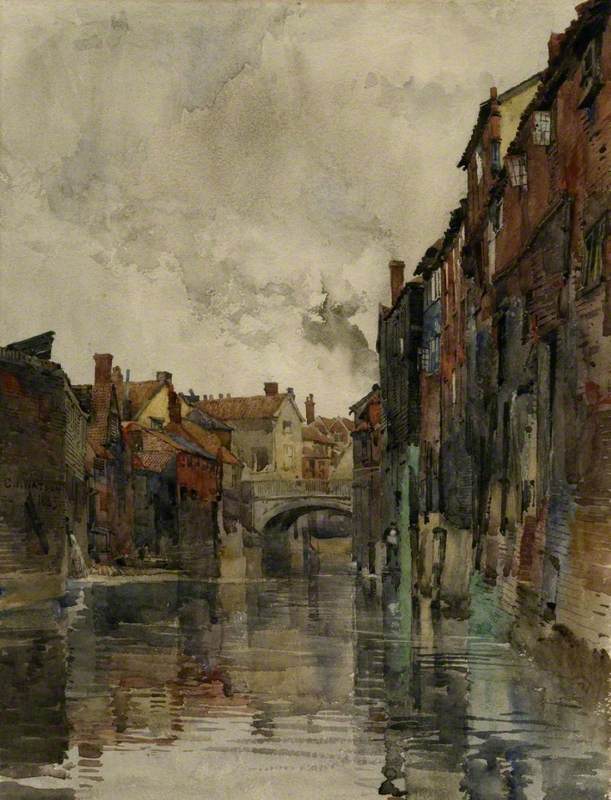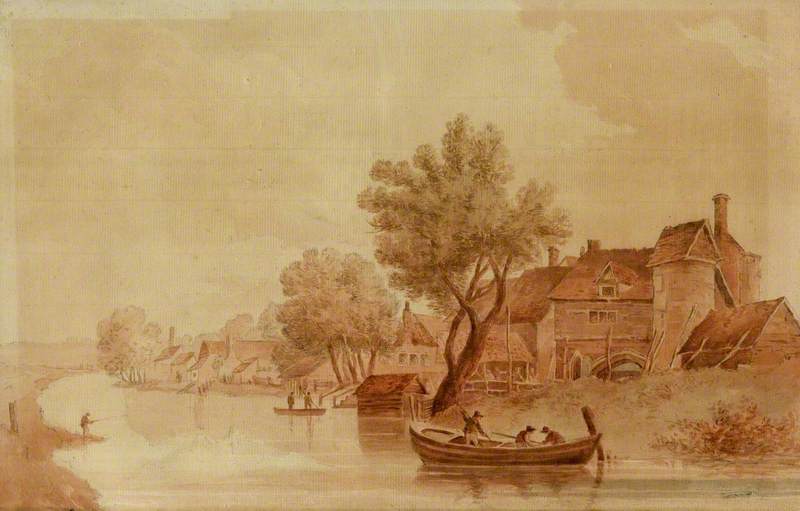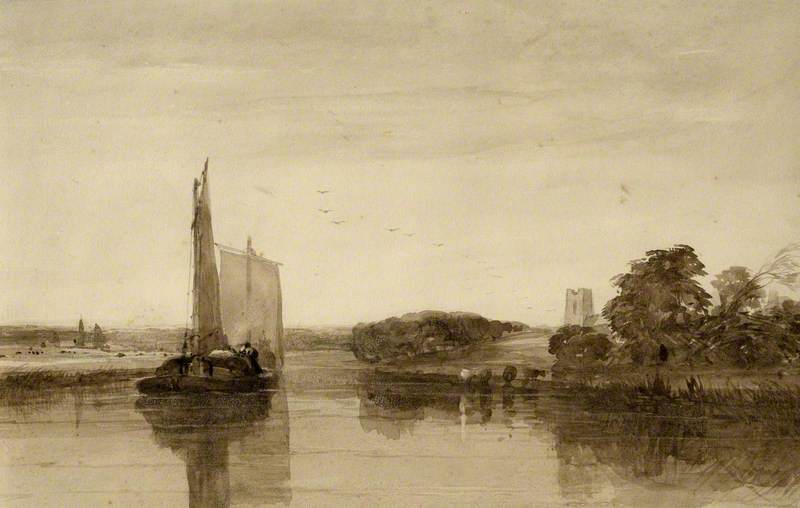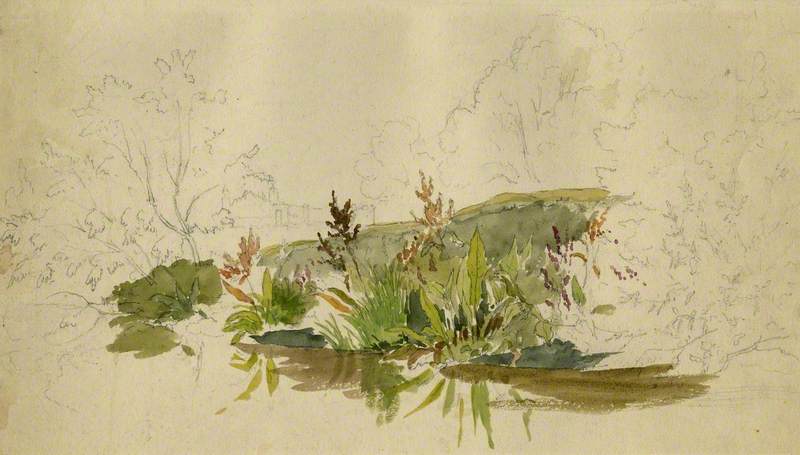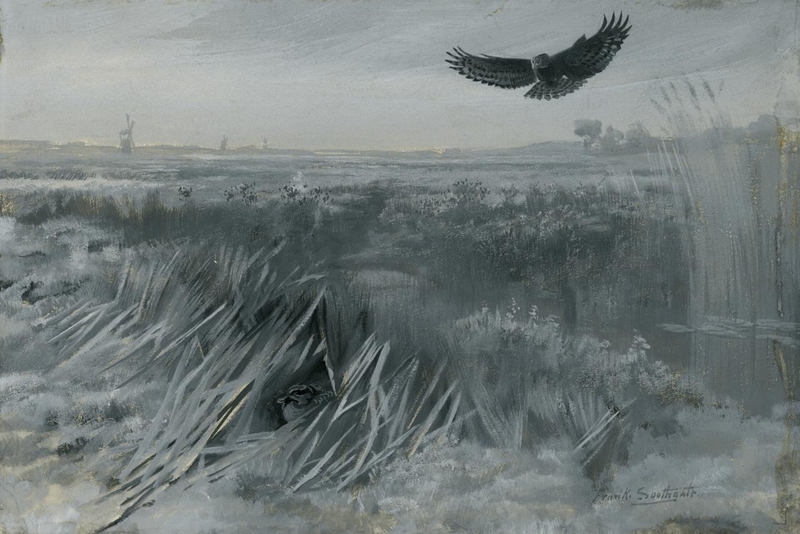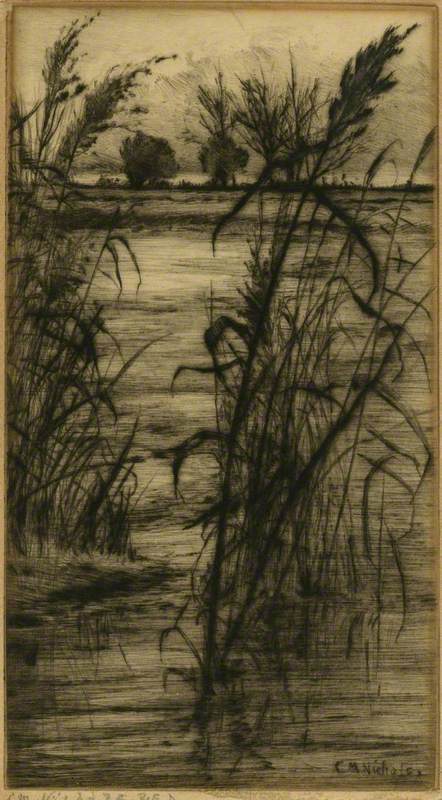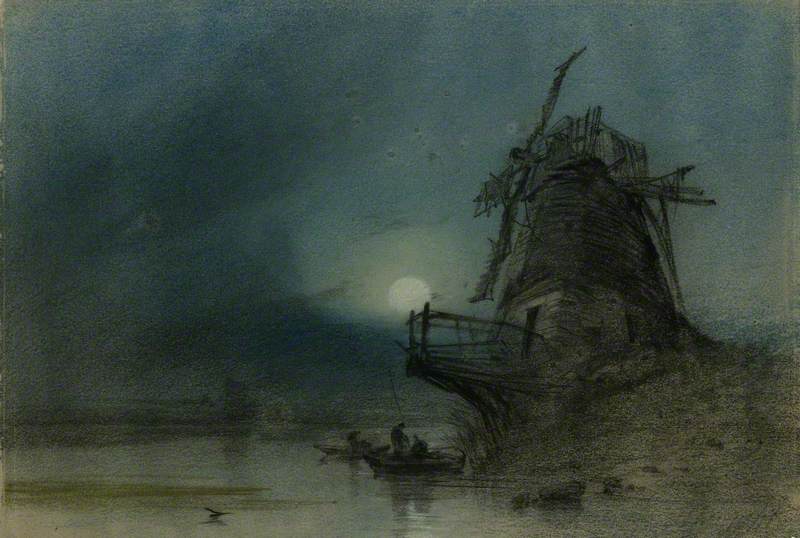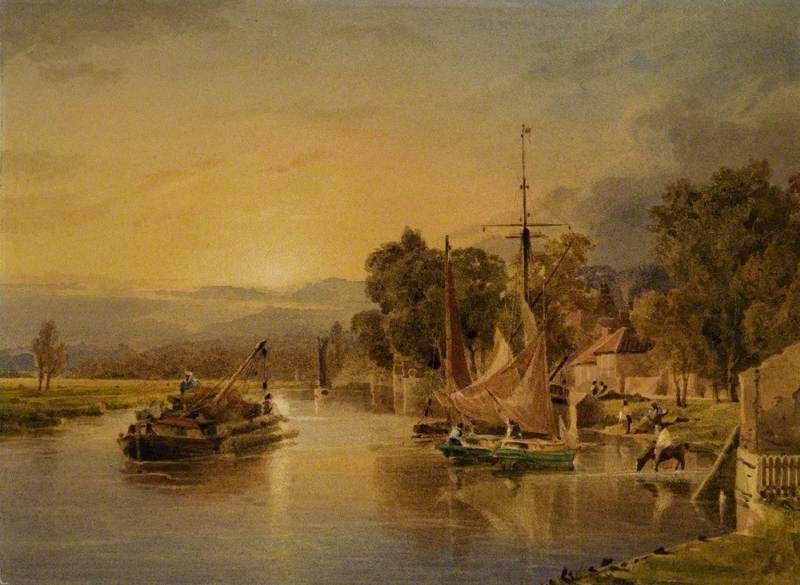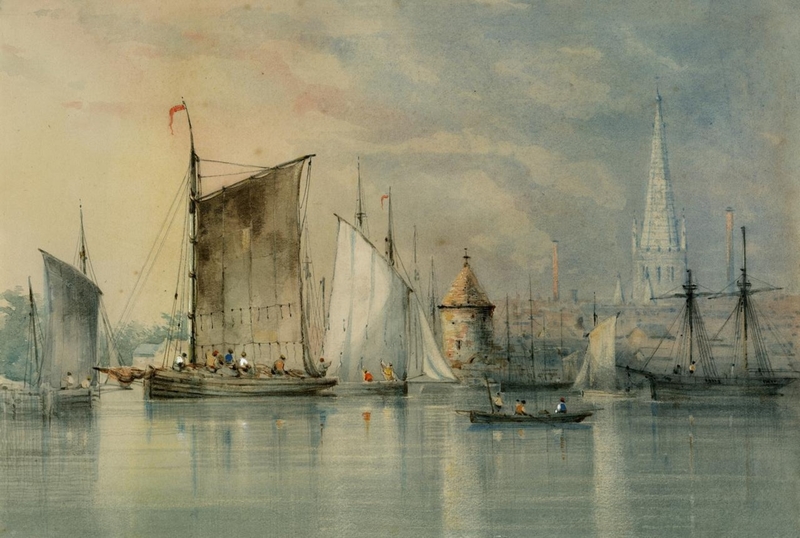This exhibition, curated by Dr Giorgia Bottinelli, Curator of Historic Art, was due to open at Norwich Castle Museum and Art Gallery on 30th March 2020. Due to lockdown, we have made a special selection of artworks available on this platform instead.
-
Wherries in Sail on the River 19th C
Over the years, generations of artists have captured many aspects of Norfolk’s iconic Broads and rivers. Some of these artworks highlight the rivers’ importance as arteries for transporting goods and people; others emphasise them as sites of leisure and homes to rare species of flora and fauna.
Looking at these drawings and watercolours now, we can see how drastically Norwich and Norfolk have changed over the last two centuries. Thankfully, many of our waterways are now protected, preserving the breath-taking landscape, plants, birds and animals for future generations.
Thomas Lound (1802–1861)
Watercolour on paper
H 9.2 x W 12.5 cm
Norfolk Museums Service
-
Fish Traps by Bridge early 19th C
Norfolk’s coast and rivers used to be home to a thriving fishing industry. Although this work by James Stark is sketchy and would have been rapidly drawn, he took great care in depicting the fish traps and other fishing equipment next to a bridge.
James Stark (1794–1859)
Pencil & white chalk on paper
H 25.5 x W 30.6 cm
Norfolk Museums Service
-
The Eel Boat 1820s
This watercolour shows a fisherman about to raise his nets. Norfolk’s waterways were once teeming with eels, and eel boats were a common sight. Nets were spread on the riverbed at night when the tide was ebbing, and the fishermen slept in the covered boat overnight.
John Sell Cotman (1782–1842)
Watercolour and bodycolour, over graphite on paper
H 17.2 x W 26.3 cm
Norfolk Museums Service
-
Boulton and Paul, Norwich 1918
The Norwich firm that became Boulton and Paul started life as an ironmonger’s shop in 1797. In the 1880s it was a leading manufacturer of corrugated iron buildings and in 1915 it began to construct aircraft. Before the First World War it moved to premises at Thorpe Yard, near the railway station, where it remained until its closure in the 1980s. In the 1990s the site was decontaminated, raised and redeveloped; it is now the shopping and leisure complex known as Riverside Entertainment.
Arthur Weston (active c.1893–1917)
Pencil & watercolour on paper
H 22.9 x W 19.2 cm
Norfolk Museums Service
-
View on the River Wensum, Norwich early 19th C
John Thirtle painted this lively watercolour for James Stark, a fellow member of the Norwich Society of Artists. It has been said that the warehouses and buildings on the right depict dye works belonging to James Stark’s father Michael, situated on the left bank of the river Wensum on Duke Street.
Many of Thirtle’s watercolours have faded badly, but this early drawing still retains its original silver, pink and brown hues.
John Thirtle (1777–1839)
Pencil, watercolour & bodycolour on paper
H 26.5 x W 38.9 cm
Norfolk Museums Service
-
Fye Bridge, Norwich 1885
A wooden version of Fye Bridge was first recorded as far back as 1153. In the 1640s, it was the site where women accused of witchcraft were submerged in water while tied to a chair. If they drowned, they were cleared of all charges; if they survived, they were executed.
In 1829, the earlier stone bridge was replaced by the cast iron structure with railings shown in this work. Unfortunately, the view shown here, with buildings right along the waterline, no longer exists, as the river Wensum was widened to prevent flooding and a new bridge was built in 1933.
Charles John Watson (1846–1927)
Pencil & watercolour on paper
H 40.6 x W 32 cm
Norfolk Museums Service
-
Sandling's Ferry, Norwich late 18th C–early 19th C
The ferry and building known as ‘Sandling’s Ferry’ until the late eighteenth century are now known as ‘Pull’s Ferry’ after John Pull, the ferryman between 1796 and 1841.
First dug on this spot in the eleventh century, an ancient canal towards the site now known as the Cathedral Close was initially used to transport building materials, then heavy goods to the Cathedral. The arched water gate was built in the fifteenth century and in 1647 a house and inn were built to its left. In 1772 the canal was covered over.
Robert Ladbrooke (1770–1842)
Pencil & watercolour on paper
H 28.5 x W 43.6 cm
Norfolk Museums Service
-
Study of Ships 1829
This pair of ships in calm waters demonstrate Stannard’s skill at depicting marine and shipping subjects.
Joseph Stannard (1797–1830)
Pencil & pastel on paper
H 41.3 x W 30.7 cm
Norfolk Museums Service
-
River Scene with Wherries early 19th C
Wherries are particularly associated with the Norfolk rivers, as well as the rivers Thames and Cam. The Norfolk wherry is a distinctive type of boat with a single high-peaked sail.
This serene scene, rendered in pencil and brown wash, depicts wherries loaded with cargo sailing on a tranquil river while cows graze on the riverbank, brilliantly evoking the peacefulness of a summer afternoon.
Thomas Lound (1802–1861)
Pencil & brown wash on paper
H 25.8 x W 40.4 cm
Norfolk Museums Service
-
St Anne's Wharf
Here Montague depicts people boating and fishing on the river Wensum, with St Anne’s Wharf, a large brewery site on King Street, in the background. Historically, St Anne’s Wharf was also the site of a monastery and church until the sixteenth century and a Synagogue in the nineteenth century.
Arthur Montague (active c.1872–c.1875)
Watercolour on paper
H 30.3 x W 45.6 cm
Norfolk Museums Service
-
Foliage by a Stream early 19th C
This unfinished watercolour focuses on the plants and bushes growing on the bank of a stream, with a building just indicated in the background. James Stark was a pupil of John Crome and an assured draughtsman.
James Stark (1794–1859)
Pencil & watercolour on paper
H 21.8 x W 37.8 cm
Norfolk Museums Service
-
Marsh Harrier and Wounded Teal
Marsh Harriers were a common sight on the waterways of East Anglia but their numbers dwindled in the nineteenth and twentieth centuries as a result of hunting and loss of habitat. They were successfully reintroduced to Norfolk in the 1990s and can once again be seen hovering over the reed beds and marshes of the North Norfolk coast.
Frank Southgate (1872–1916)
Watercolour on paper
H 25.4 x W 36.6 cm
Norfolk Museums Service
-
Untitled late 19th C–early 20th C
Norwich-born Catherine Maude Nichols was a skilled painter and printmaker. She studied at the Norwich School of Art and first exhibited at the Royal Academy in 1877. In 1882 she became one of the first female fellows of the Royal Society of Painter-Etchers. Like many of her etchings, this print is a scene in Norfolk, and specifically of Norfolk wetlands.
Catherine Maude Nichols (1847–1923)
Etching on paper
H 25.1 x W 13.3 cm
Norfolk Museums Service
-
Old Mill, Moonlight mid-19th C
The atmosphere in this chalk drawing is one of eerie stillness with everything in shadow. A hazy moon reflected in the smooth water casts the hunched figures in the boats in silhouette. The fluency with which Bright has drawn the windmill demonstrates his great skill as a draughtsman.
Henry Bright (1810–1873)
Black, white & coloured chalk on paper
H 22.8 x W 33.1 cm
Norfolk Museums Service
-
Thorpe Staithe 1829
John Thirtle was one of the finest watercolour artists of the Norwich Society, but sadly many of his watercolours, like this one, have suffered from fading and discoloration. With its angular forms, illuminated by an all-enveloping light, this is a typical late work. It may well have been that exhibited with the Norwich Society in 1829, when the local press praised Thirtle for the ‘rich harmonious tone [of] his watercolour painting’.
John Thirtle (1777–1839)
Pencil, watercolour & bodycolour on paper
H 25.3 x W 34.2 cm
Norfolk Museums Service
-
The River at Yarmouth with River Tower and St Nicholas Church 19th C
William Philip Barnes Freeman was a member of a Norwich family firm of carvers, gilders and mirror manufacturers, who also sold prints and artists’ materials and carried out picture restoration. Freeman was taught watercolour and drawing by John Sell Cotman and oil painting by John Berney Ladbrooke.
This is a tranquil depiction, and the water has a glass-like surface. Light comes from the sun shining from behind the sails of the wherries and sailing boats.
William Philip Barnes Freeman (1813–1897)
Watercolour & pencil on paper
H 27.8 x W 38.2 cm
Norfolk Museums Service
Explore artists in this Curation
View all 13-
 Catherine Maude Nichols (1847–1923)
Catherine Maude Nichols (1847–1923) -
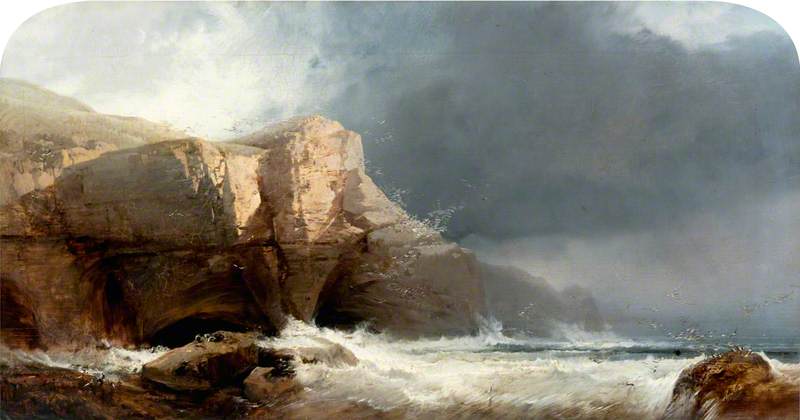 Henry Bright (1810–1873)
Henry Bright (1810–1873) -
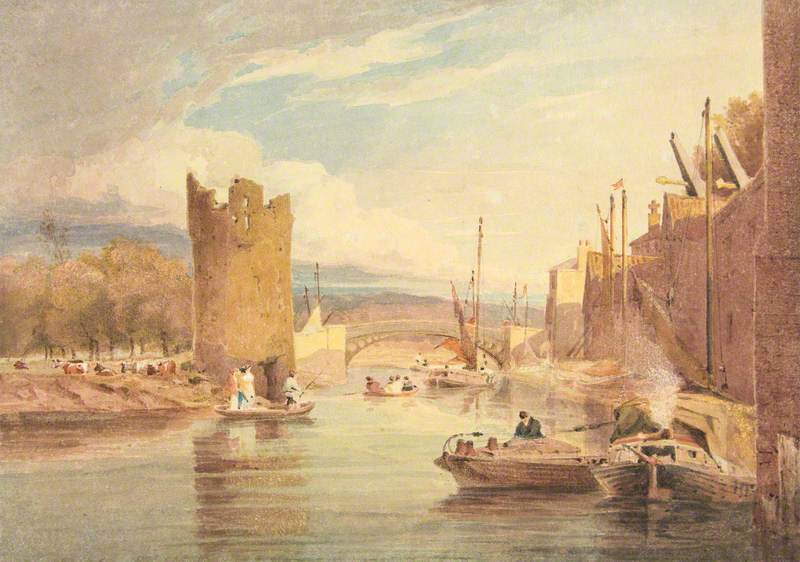 John Thirtle (1777–1839)
John Thirtle (1777–1839) -
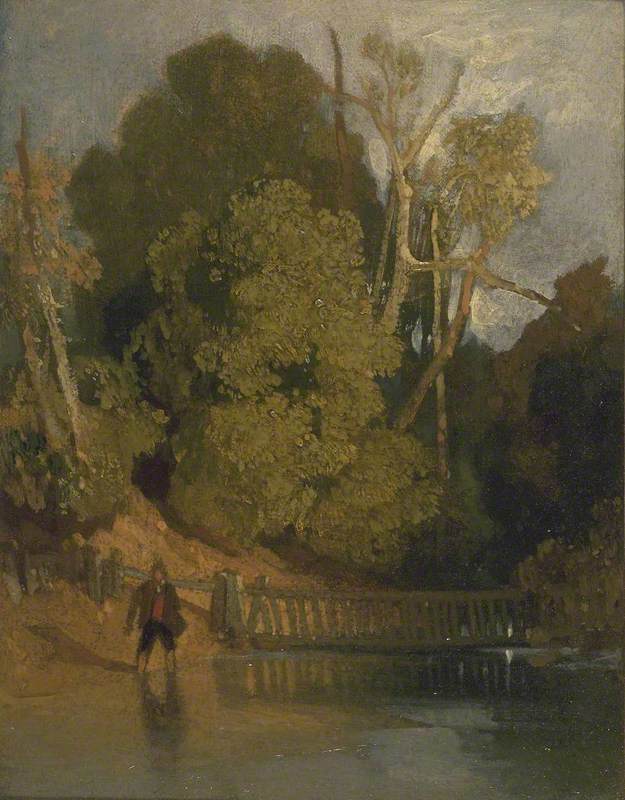 John Sell Cotman (1782–1842)
John Sell Cotman (1782–1842) -
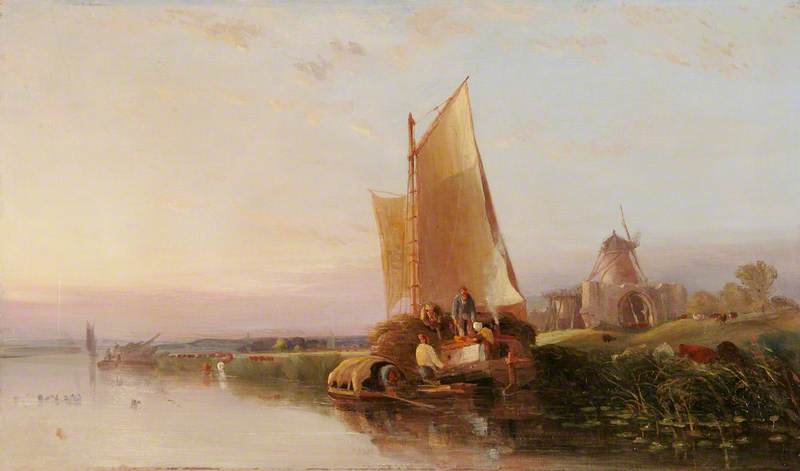 Thomas Lound (1802–1861)
Thomas Lound (1802–1861) -
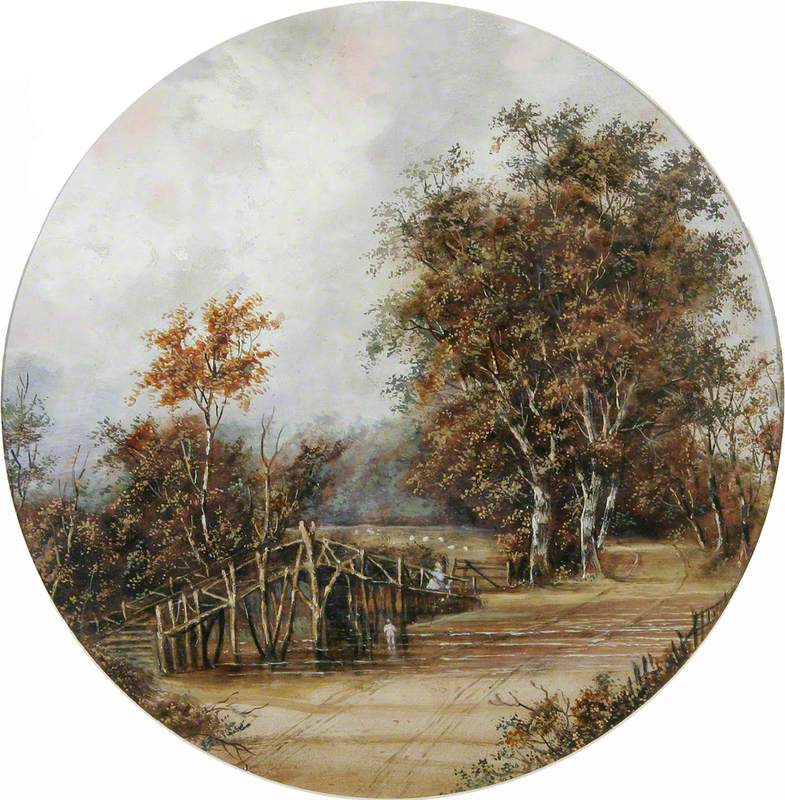 William Philip Barnes Freeman (1813–1897)
William Philip Barnes Freeman (1813–1897) -
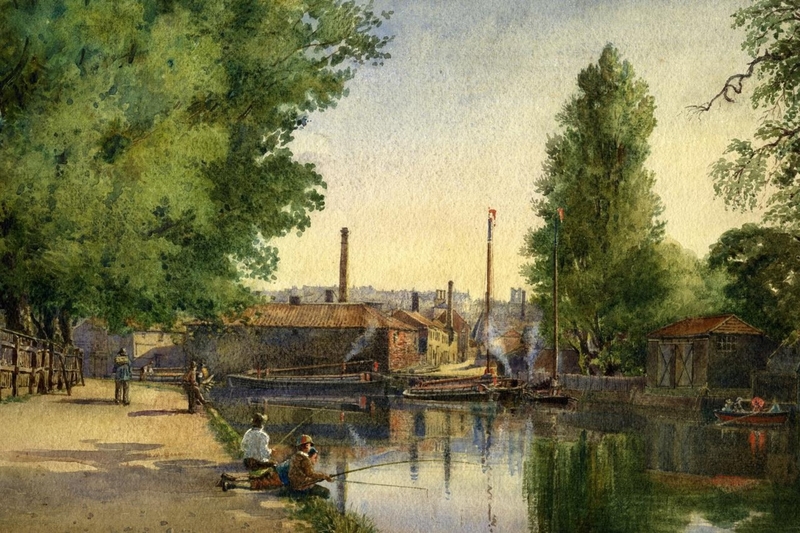 Arthur Montague
Arthur Montague -
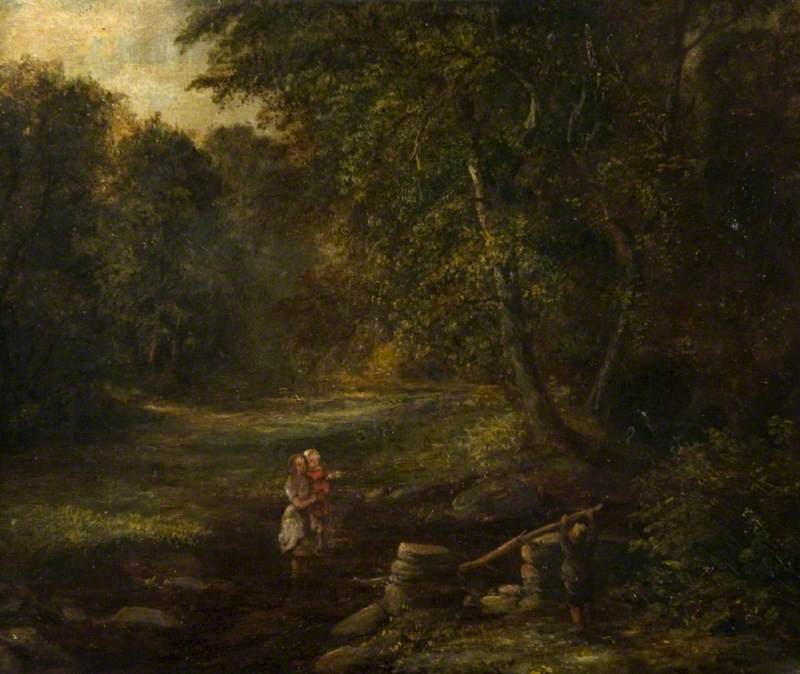 James Stark (1794–1859)
James Stark (1794–1859) -
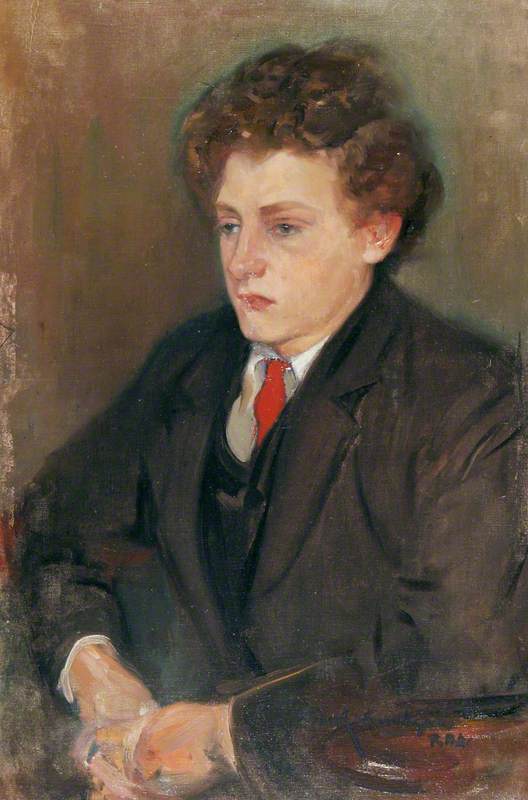 Frank Southgate (1872–1916)
Frank Southgate (1872–1916) -
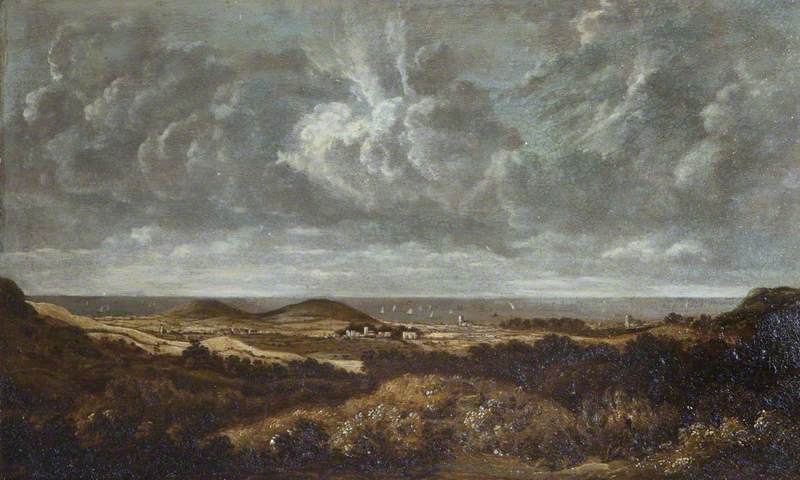 Robert Ladbrooke (1770–1842)
Robert Ladbrooke (1770–1842) - View all 13
